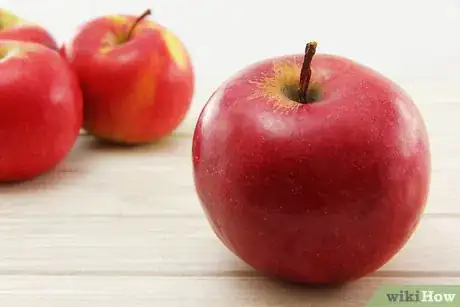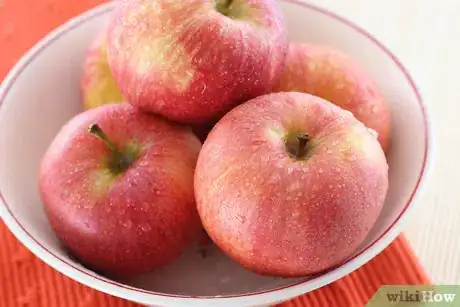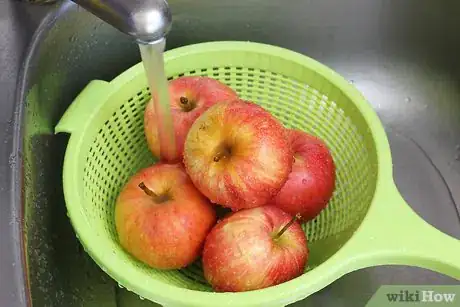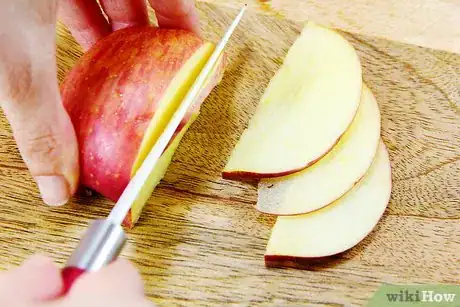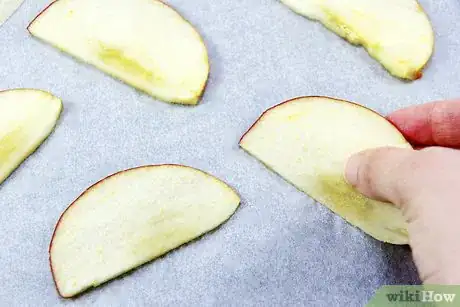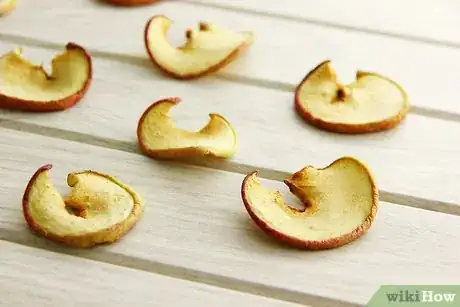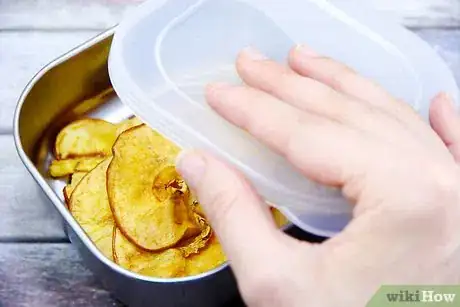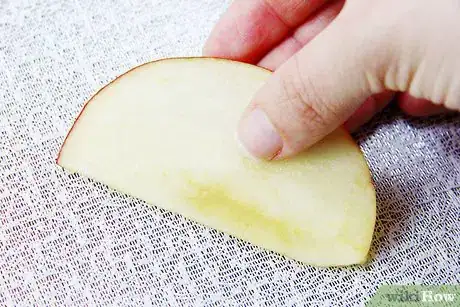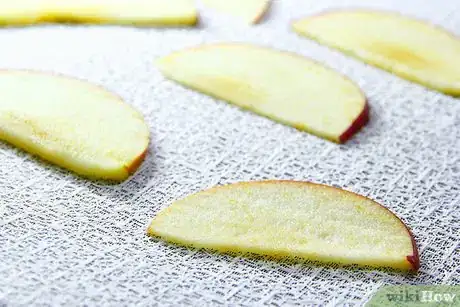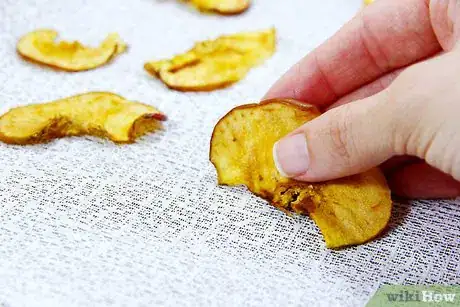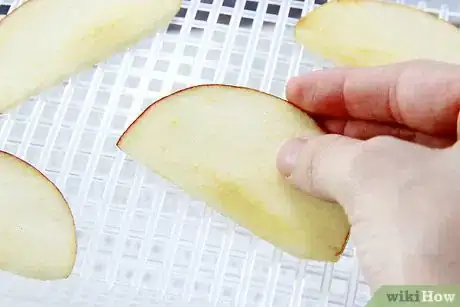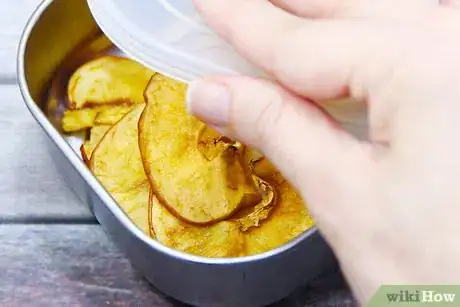This article was co-authored by wikiHow Staff. Our trained team of editors and researchers validate articles for accuracy and comprehensiveness. wikiHow's Content Management Team carefully monitors the work from our editorial staff to ensure that each article is backed by trusted research and meets our high quality standards.
wikiHow marks an article as reader-approved once it receives enough positive feedback. In this case, 97% of readers who voted found the article helpful, earning it our reader-approved status.
This article has been viewed 383,746 times.
Learn more...
Dried fruit is a good source of nutrients and is filled with vitamins and minerals. It is also rich in natural sugar. You can dry a wide variety of fruits, including grapes (sultanas, currants and raisins), apples (sliced), apricots, pears, peaches, figs, dates, plums (prunes) and bananas. Dried fruit is a great way to keep summer's harvest feeding you through the winter season and it won't take long for you to learn the art of drying fruit.
Steps
Selecting Fruits for Drying
-
1Select fruits that are suitable for drying. Not all fruits will dry well, so focus only on the ones known to produce excellent results when dried. These include:
- Vine fruits such as grapes. Note that grapes produce different types of dried fruits: Zante currants come from from a tiny, seedless black grape; sultanas come from a sweet, seedless green/white grape; and raisins come from large, sweet grapes such as muscat.[1]
- Tree fruits such as stone fruit (apricots, peaches, plums, nectarines), mangoes, bananas, apples, figs, dates and pears.
-
2Choose ripe fruit. Make sure that the fruit you use is mature, firm, and ripe. Fruit that is damaged, unripe, or overripe will lack nutritional value, won't dry as well, and won't taste as good since the sugars aren't at their peak stage of development.[2]
Preparing Fruits for Drying
-
1Wash the fruit. Rinse the fruit under cool, running water, scrubbing it gently with your fingers to remove any visible dirt or debris. Pat the fruit dry with a clean paper towel when finished.
- For small vine fruits, like berries or grapes, you could place the fruit in a colander and rinse it that way.
-
2Cut larger fruit into into very thin slices. Most tree and bush fruits need to be cut into slices roughly 1⁄8 to 1⁄4 inch (0.3 to 0.6 cm) thin, but many small vine fruits (berries and grapes) can be left whole.[3]
- Grapes or berries with inner seeds might need be sliced in halves and de-seeded.[4]
- You should also trim away any stems or leaves at this time.
-
3Lay fruit on a parchment covered cooking sheet. The fruit slices should be in an even, single layer and should not touch each other.
- If using a dehydrator, place the fruit on a dehydrator tray instead of using a parchment-lined cooking sheet.
- If rack drying outdoors, place the fruit on your drying rack instead of using a cooking sheet.
Drying the Fruits
Oven Drying
-
1Place tray of fruit in oven. Preheat the oven to its lowest setting (150-200 degrees F / 50 degrees C).[5] You need only to dry the fruit, not to cook it. After the oven is fully preheated, place the cooking sheet of fruit inside.
-
2Dry for 4 to 8 hours. Depending on the type of fruit, the exact oven temperature, and the thickness of the slices, fruit can take anywhere from 4 to 8 hours to dry. Keep an eye on the fruit to make sure that it shrivels up without burning.
- The drying process will take several hours by necessity; do not try to increase heat to speed up drying process, since doing so will burn the fruit and make it inedible.
-
3Remove from oven when fruit is sufficiently dehydrated. Fruit should be chewy, not crunchy or squishy.
-
4Enjoy now or store for later.
Rack Drying Outdoors
-
1Choose a hot day. Temperatures need to be at least 86 degrees Fahrenheit (30 degrees Celsius), if not hotter. Also note that outdoor drying takes several days, so you'll need a consistent heat spell.[6]
- The humidity should also be below 60 percent while you dry, and the weather should be both sunny and breezy.
-
2Place the fruit on screens. Choose stainless steel, teflon coated fiberglass, or plastic. Keep the fruit in an even layer.[7]
- Most wood trays also work, but avoid green wood, pine, cedar, oak, and redwood.
- Also avoid using hardware cloth (galvanized metal cloth).
-
3Place the tray in sunlight. Set the tray of fruit on two blocks to keep it off the ground. Cover loosely with cheesecloth, and let it sit out in direct sunlight.
- It's important to keep the trays off moist ground. Setting them on blocks also improves air flow and speeds drying.
- Consider placing a tin or aluminum sheet beneath the tray to reflect more sunlight and speed drying.
- Covering the trays will protect them from birds and insects.
- Move the trays under shelter at night since the cool evening air can introduce moisture back into the fruit.
-
4Collect the fruit after several days. Drying fruit using this method will take several days. Monitor the progress several times each day until the fruit seems shriveled and chewy.
Drying with a Dehydrator
-
1Set the dehydrator to its "fruit" setting. If no such setting exists, set the temperature to 135 degrees Fahrenheit (57 degrees Celsius).[8]
-
2Dry the fruit for 24 to 48 hours. Spread the fruit over the dehydrator rack in a single layer. The exact amount of drying time will vary by fruit and thickness, but it will usually be ready after one or two days.
- Begin checking the fruit after the first 24 hours to prevent it from over-drying. Afterward, check on it every 6 to 8 hours.
-
3Collect the finished fruit. When ready, the fruit should be shriveled and chewy. Squeeze it gently; it should be fairly rigid since the moisture has been drawn out of the squishy flesh.
Storing and Using the Dried Fruits
-
1Store in an airtight container in a cool place. Stored in this manner, most dried fruits will last from 9 to 12 months. Packaged dried fruits should be consumed faster once opened, and may need to be stored in the refrigerator in a sealed bag, to prevent deterioration. This is especially so if the original dried fruits are still somewhat moist rather than completely dehydrated.
-
2Use dried fruits for cooking, baking and eating as they are. Some dried fruits can be rehydrated by stewing or soaking in warm water. This is typically done for such dried fruits as apples, apricots, peaches, prunes and pears. Dried mangoes and pawpaw can be rehydrated by leaving in cold water for an hour before using. Other dried fruits can be revived by soaking in alcohol, such as sultanas, currants and raisins, before using in traditional recipes such as dried fruit cake or pudding.
Community Q&A
-
QuestionWhat do I put to keep apricot from turning black?
 Community AnswerSmoke the apricots with burning sulphur before drying or spray with sodium metabisulphate solution, then dry them. Be aware that some people will have an allergic reaction to sulphur.
Community AnswerSmoke the apricots with burning sulphur before drying or spray with sodium metabisulphate solution, then dry them. Be aware that some people will have an allergic reaction to sulphur. -
QuestionHow do I dry bananas?
 Community AnswerCut the banana into small pieces. Put them in an oven for six hours to dry.
Community AnswerCut the banana into small pieces. Put them in an oven for six hours to dry. -
QuestionHow do I dry apples?
 Community AnswerCut some apples into thin slices, and soak the slices in lemon water (4 cups water, 1/2 cup lemon juice) for 30 minutes. Arrange the slices on a large baking sheet, and bake in an oven for 1 hour at 200F. Turn the slices over, and then bake them for another 1 to 2 hours. Turn the oven off, and let the slices sit for 1 to 2 hours before taking them out.
Community AnswerCut some apples into thin slices, and soak the slices in lemon water (4 cups water, 1/2 cup lemon juice) for 30 minutes. Arrange the slices on a large baking sheet, and bake in an oven for 1 hour at 200F. Turn the slices over, and then bake them for another 1 to 2 hours. Turn the oven off, and let the slices sit for 1 to 2 hours before taking them out.
Warnings
- Fruit hung to dry may need protection from insects or other contaminants.⧼thumbs_response⧽
Things You'll Need
- Firm fruit
- Knife or slicer
- Oven
- Cooking Sheet
- Baker's parchment
- (sugar)
- a cutting board
References
- ↑ https://www.thekitchn.com/whats-the-difference-between-raisins-sultanas-and-currants-223285
- ↑ http://www.backpackingchef.com/dehydrating-fruit.html
- ↑ http://www.backpackingchef.com/dehydrating-fruit.html
- ↑ http://dontwastethecrumbs.com/2013/08/how-to-dehydrate-fruit-basic-food-preservation/
- ↑ https://www.thekitchn.com/how-to-dry-fruit-in-the-oven-92637
- ↑ http://nchfp.uga.edu/publications/uga/uga_dry_fruit.pdf
- ↑ http://nchfp.uga.edu/publications/uga/uga_dry_fruit.pdf
- ↑ http://dontwastethecrumbs.com/2013/08/how-to-dehydrate-fruit-basic-food-preservation/
About This Article
To make dried fruits, start by cutting some fruit into thin slices. If you're drying small fruits like berries, you can leave them whole. Then, spread the fruit out on a lined baking sheet and put it in the oven. Let the fruit dry for 4-8 hours at your oven's lowest temperature setting. Once the fruit is finished drying, take it out of the oven and serve or store for later! If you want to learn how to use a dehydrator or dry your fruits outside, keep reading the article!
